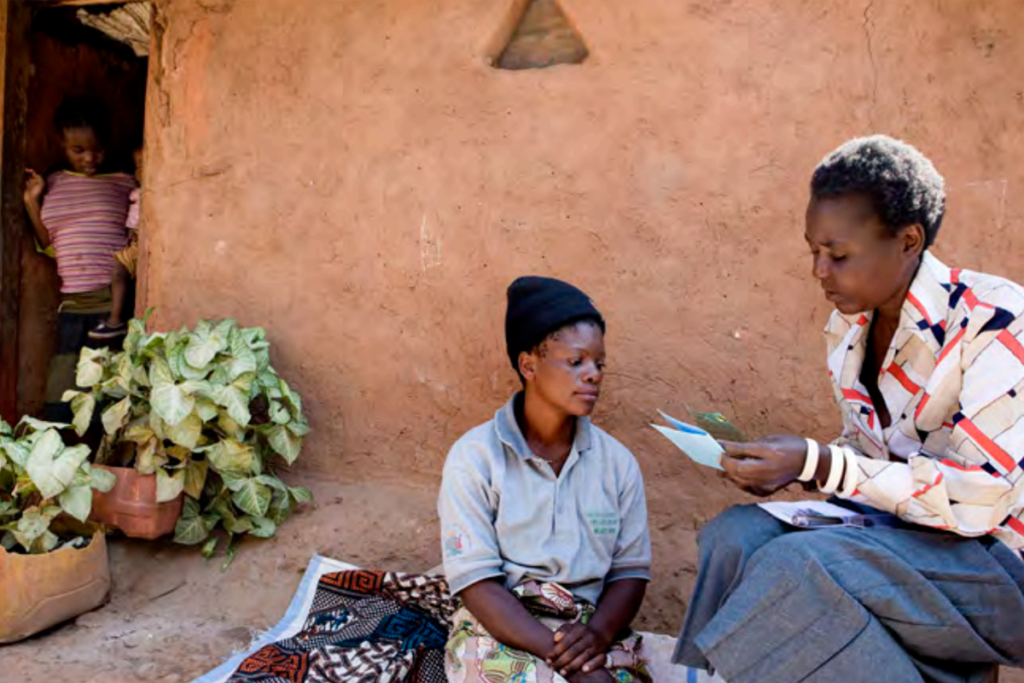The original launch of the UNAIDS 90-90-90 goals in 2014 reflected a fundamental shift in global commitment to HIV treatment. The strategy called for 90% of people living with HIV to be diagnosed, 90% of those diagnosed to be treated, and 90% of those treated to be virally suppressed by 2020. As exacting and ambitious as these goals might have been, the trend over the past few years has been remarkable, especially for the first 90.
Progress towards the first 90 (diagnosis) in Zimbabwe was estimated at 74.2% in 2016. The Zimbabwe Ministry of Health and Child Care promoted the use of index testing and partner notification services to reach the untested and close the deficit. The Zimbabwe HIV Care and Treatment (ZHCT) project, funded by USAID and implemented by FHI 360 and Plan International, supported the Ministry’s efforts by adopting index testing and partner notification services as part of its community HIV testing program. In this post, I explore Nyikadzino Mahachi and his colleagues’ new paper that highlights the ZHCT project team’s implementation results and experiences.
What is index testing and partner notification services?
Index testing and partner notification services are premised on the fact that people’s knowledge of their HIV status, as well as their partner’s status, is critical to global HIV prevention, risk reduction and treatment. The services are important for the management of not only HIV/AIDS, but also other sexually transmitted infections and non-communicable diseases.
The ZHCT project, research goal and approach
In this study, the ZHCT project collaborated with nurses in public-sector facilities and supported community nurse testers and outreach workers to offer index testing and partner notification services to partners and biological children of index clients across 12 districts in the rural provinces of Manicaland, Masvingo and Midlands from March 2016 to May 2018. Mahachi et al. defined index clients as people who are newly or recently diagnosed (within six months) as HIV positive and registered at one of 317 public-sector health facilities.
Besides testing clients for HIV, the ZHCT project allowed outreach workers to test contacts for non-communicable diseases (i.e., hypertension, diabetes, malnutrition), other sexually transmitted diseases and tuberculosis. The community nurse testers also discussed family planning options and distributed condoms. Clients who tested HIV positive or tested abnormally on other screenings were referred to the appropriate health facility for care.
To assess the project’s performance, Mahachi et al. relied on corresponding HIV testing data from the district health information system (DHIS-2), which was validated using service registers. The researchers used Microsoft Excel and SPSS, respectively, to calculate the monthly HIV positivity rates and assess the statistical differences in paired monthly HIV positivity rates by sex, testing site and province.
The ZHCT project results
Consistent with other studies in Cameroon (Henley et al., 2013), Kenya (Cherutich et al., 2017), Tanzania (Kahabuka et al., 2017) and Uganda (Buhikire et al., 2018), Mahachi et al. found strong evidence of high HIV case-finding through index testing and partner notification services. Over the 27-month period, the ZHCT project registered 27,704 index clients – 95.1% of whom consented to participate in index testing and partner notification services. These index clients further provided 55,149 additional contacts who received HIV testing services. Of this number, 15,944 tested positive for HIV (29%) out of which 12,152 were initiated on antiretroviral therapy.
The researchers observed variations in HIV positivity rates across different age groups, contacts’ relationship to index cases, province and sex. People within the age brackets of 40–44 and 45–49 years had the highest HIV positivity rates, reaching 39.3% and 42.7% respectively. When it came to the relationship between index clients and contacts, sexual partners had the highest positivity rate of 46.1% compared to 16.6% for contact children and 15.4% for other relatives in the household. At the provincial level, Manicaland had the lowest HIV positivity rate (19.5%), behind Masvingo (28%) and Midlands (41%). The HIV positivity rate between males and females also respectively stood at 27.4% and 30.3% – marginal, but significantly high.
The ZHCT project started with an HIV positivity rate as low as 10% in the first six months, but over the course of the study witnessed a significant and sustained positivity rate of greater than 30%. While this is attributable to a shift in strategy to improve targeting by the community nurse testers and limit testing to sexual partners and biological children of index clients, it also points to the feasibility, efficiency and effectiveness of index testing and partner notification services.
My thoughts
I am convinced that the ZHCT project provides an interesting example of how to do a better job of identifying HIV cases through index testing and partner notification services. Notwithstanding, it is also important to note that both approaches to HIV case-finding, despite their effectiveness, have been criticized, though infrequently, for resulting in intimate partner violence (Rothenberg et al., 1995; Tih et al., 2019; Cherutich et al., 2017). I would have loved to see how this issue manifests itself when index testing and partner notification services are implemented at scale.
Similarly, while I agree that the number of people accepting to be tested for HIV was impressive, I would have liked to see Mahachi et al. present data on the number of people who declined HIV testing services and why. That way, better and more effective targeting strategies can be explored in future interventions in Zimbabwe as well as in other African countries.
I commend the researchers for integrating additional services beyond HIV screening. Clearly, this approach has strong potential for increasing people’s willingness to participate in index testing and partner notification services. What I could not see in the paper, however, is whether such complementary services played any role, significant or otherwise, in enticing index clients and contacts to avail themselves for HIV testing.
Photo credit: FHI 360



